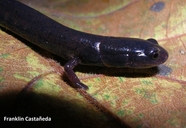|
Oedipina tomasi McCranie, 2006
Tomas' Worm Salamander Subgenus: Oedopinola | family: Plethodontidae subfamily: Hemidactyliinae genus: Oedipina |
| Species Description: McCranie JR 2006 New Species of Oedipina (Amphibia: Caudata) from Parque Nacional El Cusuco,Northwestern Honduras. Journal of Herpetology 40(3): 291 | |
 © 2018 Franklin Castaneda (1 of 1) |
|
|
|
Description Oedipina tomasi lacks pale brown and white patches on its head and body that are present in O. elongata. Additionally, O. tomasi has numerous maxillary teeth, unlike in O. elongata, which has none. Oedipina tomasi has a dark black body with pale flecks as opposed to the browner body and absence of flecking in O. gephyra, and is larger in size. One segment of its longest toe is unwebbed, in contrast to the full webbing with only one toe tip protruding in O. gephyra. Oedipina tomasi has distinct digital grooves and transverse grooves at the proximal edges of digits, unlike O. petiola, whose digital grooves are less pronounced, and lacks proximal grooves altogether (Brame 1968, McCranie and Townsend 2011). In life, the iris, as well as the dorsal and ventral areas of the body and tail, are dark black. The area between and below the nasolabial grooves is light brown and has brown marks. The top of the head is blackish gray, the underside of the head is black, and the dorsal edges of the limbs are dark brown. Pale brown marks are present on the limbs and the underside of the head. White marks are found on the ventral portion of the body. When preserved in alcohol, body color is unchanged one month after collection, except the white marks found on the ventral surface of the body lose visibility, and when viewed under magnification, small pale iridophores become visible (McCranie 2006). Though only two specimens have been described, it seems that this species is sexually dimorphic in body size, with males being smaller than females. Females have four premaxillary teeth (versus two in males) located in line with 48 maxillary teeth (versus 58), and have cloacal folds, which are absent in males. Females also lack a mental gland lip projections, which are present in males (McCranie 2006). Distribution and Habitat Country distribution from AmphibiaWeb's database: Honduras
Life History, Abundance, Activity, and Special Behaviors Trends and Threats Relation to Humans Possible reasons for amphibian decline General habitat alteration and loss Comments According to maximum likelihood analysis, O. tomasi forms a clade with sister taxa O. gephyra and O. petiola, most closely related to O. gephyra, as supported by Bootstrap values used to create a Bayesian phylogram. (McCranie and Townsend 2011). The species name tomasi was chosen to honor James McCranie’s good friend, Tomás Ruiz, who was central to the discovery and collection of the species (McCranie 2006). Over a course of 24 collecting days, researcher James McCranie collected two specimens (McCranie 2006). One specimen was later checked for chytrid in 2010, and no evidence of the fungus was found (Kolby et al. 2009).
References
Brame, A. H., Jr. (1968). "Systematics and evolution of the Mesoamerican salamander genus Oedipina." Journal of Herpetology, 2, 1-64. [link] Castaneda, F. 2008. Oedipina tomasi. The IUCN Red List of Threatened Species. Version2014.3. http://www.iucnredlist.org/ Kolby, J. E., Padgett-Flohr, G. E., and Field, R. (2009). ''Amphibian chytrid fungus Batrachochytrium dendrobatidis in Cusuco National Park, Honduras.'' Diseases of Aquatic Organisms, Special Edition 4, preprint 3. Published online May 6, 2009. McCranie, J. R. 2006. New Species of Oedipina (Amphibia: Caudata) from Parque Nacional El Cusuco, Northwestern Honduras. Journal of Herpetology, 40: 291-293. McCranie, J. R., Townsend, J. H. 2011. Description of a new species of worm salamander (Caudata, Plethodontidae, Oedipina) in the subgenus Oedopinola from the central portion of the Cordillera Nombre de Dios, Honduras. Zootaxa, 2990: 59-68. Originally submitted by: Andrew Antes (first posted 2015-06-17) Edited by: Gordon Lau (2015-06-22) Species Account Citation: AmphibiaWeb 2015 Oedipina tomasi: Tomas' Worm Salamander <https://amphibiaweb.org/species/6815> University of California, Berkeley, CA, USA. Accessed Nov 25, 2024.
Feedback or comments about this page.
Citation: AmphibiaWeb. 2024. <https://amphibiaweb.org> University of California, Berkeley, CA, USA. Accessed 25 Nov 2024. AmphibiaWeb's policy on data use. |




 Raffaëlli Account
Raffaëlli Account Map of Life
Map of Life